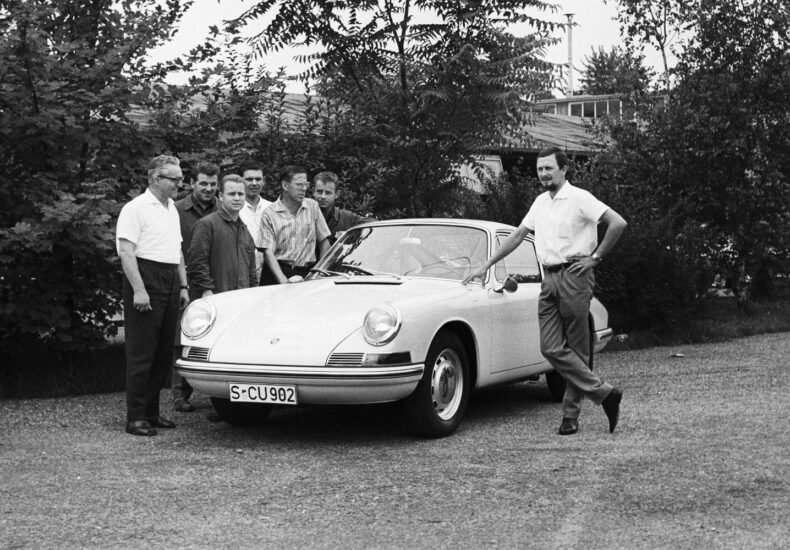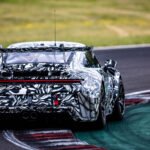
The Story of the Porsche 911
The story of the Porsche 911 began in the late 1950s. At the time, Porsche was still relatively new car manufacturer. The first Porsche production model, the 356 was unveiled in 1948. The 356 was a success, but it was aging and reaching the limits of its capabilities.
Idea of a New Sports Car
The new car had big shoes to fill. It had to be as good, or preferably better than the 356 in all areas. Customers wanted more luxury and comfort, and also more space for passengers and luggage. So the car needed to be larger and more powerful, but also as exciting to drive as the 356.
Deciding on the shape of the car was part of the body development process. Porsche didn’t have its own design department at the time, but many engineers and well-known designers had sent their proposals to Porsche. However, none of these got Ferry Porsche’s approval. After many different design studies, including a four-seater, Ferry’s son Ferdinand Alexander “Butzi” Porsche and his team created the historic design for the car.
The new car was a 2+2 seater with a hatchback on a unibody frame. Characteristic style elements included short overhangs, the distinctive headlight “tunnels” and the flat bonnet between them, and the large rear window. Like in the 356, the luggage compartment was at the front and the flat engine was situated at the rear. And to make the luggage compartment more spacious, the designers planned space-saving McPherson suspension at the front and the outdated swing axle was replaced by a semi-trailing arm suspension at the rear.
Flat-Six at the Rear
The new model was powered by a completely new six-cylinder flat engine with eight crankshaft bearings. Dry-sump lubrication ensured an adequate supply of oil, even at high longitudinal and lateral acceleration. One camshaft rotated in each of the cylinder heads, driven by intermediate shafts and a chain. With a compression ratio of 9:1, the 2.0-litre engine delivered maximum power output of 130 hp at 6,200 rpm. A newly developed five-speed transmission was used to transmit power to the rear wheels.
On the exhaust side, Porsche borrowed a tried-and-tested approach from the 356 in the shape of vehicle heating via heat exchangers. The heating pipes were routed into the sill boxes, with vents at the height of the footwell. The rear window and windscreen were supplied with hot air directly by defroster vents. In order to prevent any reduction in comfort compared to water-cooled vehicles manufactured by competitors, additional heating was provided as standard in the front of the 901.
Icon is Born
Porsche celebrated the world premiere of the 901 at the Frankfurt Motor Show on September 12 in 1963. However, this was only a pre-series vehicle. It was not until next spring when the new model could be presented to industry professionals. The series production started on September 14, 1964. The first vehicles were kept by the factory or used as exhibition vehicles.
One of them was sent to the Paris Motor Show. Everything seemed fine, when Porsche had an unexpected problem; the name of the car. Peugeot stated that they had been using three-digit numbers with a zero in the middle since 1929 and therefore owned the legal rights to all similar number sequences in France. Porsche’s sales management team suggested that the name should be changed from 901 to 911.
On October 22, 1964, Ferry Porsche gave the order for the name to be changed. From this day on, the 901 was called the 911. The icon was born.

You may also like
Latest Additions
- 2026 Porsche 911 Cup (992.2) Specs
 Here are the technical specifications of the 2026 Porsche 911 Cup one-make cup racing car based on the 992.2 generation of the 911
Here are the technical specifications of the 2026 Porsche 911 Cup one-make cup racing car based on the 992.2 generation of the 911 - Race Car: Porsche 911 Cup (2026)
 The new racing car based on the 911 for Porsche’s one-make cups and series is now officially called the Porsche 911 Cup
The new racing car based on the 911 for Porsche’s one-make cups and series is now officially called the Porsche 911 Cup - Peek Inside – 2022 Porsche 911 Carrera GTS Interior
 The interior of the 911 is sporty as standard, but Porsche still found the way to make the 2022 Porsche 911 Carrera GTS interior even sportier
The interior of the 911 is sporty as standard, but Porsche still found the way to make the 2022 Porsche 911 Carrera GTS interior even sportier - 2017 Porsche 718 Cayman MT (982) Specs
 Here are the technical specifications of the third generation 2017 Porsche 718 Cayman (type 982) with the manual transmission
Here are the technical specifications of the third generation 2017 Porsche 718 Cayman (type 982) with the manual transmission - What is the Tiptronic Transmission?
 Tiptronic is an automatic transmission system used in Porsche models known for providing a more engaging driving experience
Tiptronic is an automatic transmission system used in Porsche models known for providing a more engaging driving experience - 2018 Porsche 718 Cayman GTS PDK (982) Specs
 Here are the technical specifications of the 2018 Porsche 718 Cayman GTS with the PDK transmission. This date refers to the EU model
Here are the technical specifications of the 2018 Porsche 718 Cayman GTS with the PDK transmission. This date refers to the EU model - Porsche Design 911 Club Coupe Watch
 Porsche Design 911 Club Coupe is a limited-edition timepiece featuring unique design elements inspired by the 2026 Porsche 911 Club Coupe
Porsche Design 911 Club Coupe is a limited-edition timepiece featuring unique design elements inspired by the 2026 Porsche 911 Club Coupe - 2026 Porsche 911 Club Coupe
 Porsche is celebrating the 70 years of the Porsche Club of America, the world’s largest club for Porsche owners, with a special edition model
Porsche is celebrating the 70 years of the Porsche Club of America, the world’s largest club for Porsche owners, with a special edition model - Miami Blue 2018 Porsche 718 Cayman GTS
 How cool is the Porsche 718 Cayman GTS in blue? Check these images Miami Blue 2018 Porsche 718 Cayman GTS at sunset
How cool is the Porsche 718 Cayman GTS in blue? Check these images Miami Blue 2018 Porsche 718 Cayman GTS at sunset - 2023 Porsche 911 GT3 RS Tribute to Carrera RS Package
 In 2022, Porsche unveiled a Porsche 911 GT3 RS with a Tribute to Carrera RS Package inspired by the legendary 911 Carrera RS 2.7
In 2022, Porsche unveiled a Porsche 911 GT3 RS with a Tribute to Carrera RS Package inspired by the legendary 911 Carrera RS 2.7
